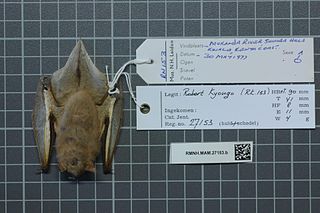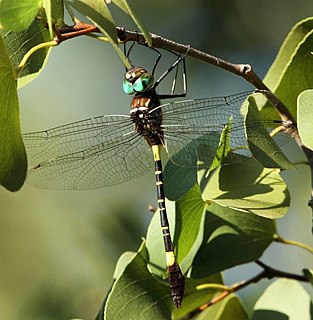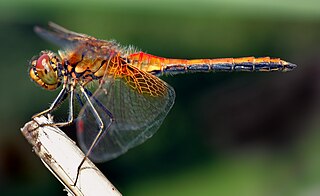The desert yellow bat is a species of vesper bat. It is found in India, Pakistan, and Bangladesh. Its natural habitats are subtropical or tropical dry forests, subtropical or tropical dry shrubland, rural gardens, and urban areas. It is threatened by habitat loss.

Rendall's serotine is a species of vesper bat. It is found in Benin, Botswana, Burkina Faso, Cameroon, Central African Republic, Chad, Republic of the Congo, Democratic Republic of the Congo, Gambia, Ghana, Kenya, Malawi, Mali, Mozambique, Niger, Nigeria, Rwanda, Senegal, Sierra Leone, Somalia, South Africa, Sudan, Tanzania, Uganda, and Zambia. Its natural habitats are dry savanna, moist savanna, subtropical or tropical dry shrubland, and subtropical or tropical moist shrubland. It is threatened by habitat loss.
Ptychadena neumanni is a species of frog in the Ptychadenidae family. It is endemic to Ethiopia.
Ptychadena tellinii is a species of frog in the family Ptychadenidae. It is found in Burkina Faso, Cameroon, Central African Republic, Democratic Republic of the Congo, Ivory Coast, Eritrea, Ethiopia, Ghana, Mali, Nigeria, Sierra Leone, Togo, possibly Benin, possibly Chad, possibly Guinea, possibly Liberia, and possibly Sudan.

The Socotra starling is a species of starling in the family Sturnidae. It is endemic to Yemen.

The tamarugo conebill is a species of bird in the family Thraupidae. It breeds in northern Chile and is a vagrant to southern Peru, and receives its name from the tamarugo, a type of shrub to which is closely associated.

Brown's pademelon is a species of marsupial in the family Macropodidae. It is found in West Papua, Indonesia and Papua New Guinea. Its natural habitats are subtropical or tropical dry forests, dry savanna, subtropical or tropical dry shrubland, and subtropical or tropical dry lowland grassland. It is threatened by habitat loss.

The robust golden mole is a species of mammal in the golden mole family, Chrysochloridae. It is endemic to South Africa. Its natural habitats are temperate forests, subtropical or tropical moist lowland forest, temperate shrubland, subtropical or tropical dry shrubland, temperate grassland, subtropical or tropical dry lowland grassland, arable land, pastureland, plantations, rural gardens, urban areas, and introduced vegetation. It is threatened by habitat loss.

The Glass's shrew is a species of mammal in the family Soricidae. It is endemic to Ethiopia. The mammal's natural habitats are subtropical or tropical high-altitude shrubland, subtropical or tropical high-altitude grassland, and swamps. It is threatened by habitat loss.

The small-footed shrew is a species of mammal in the family Soricidae. It is found in Angola, Burundi, Cameroon, Central African Republic, Chad, Democratic Republic of the Congo, Ethiopia, Kenya, Nigeria, Rwanda, South Sudan, Tanzania, Uganda, and Zambia. Its natural habitats are subtropical or tropical moist lowland forest, subtropical or tropical dry shrubland, and subtropical or tropical moist shrubland.
Phyllomacromia africana is a species of dragonfly in the family Corduliidae. It is found in the Republic of the Congo, the Democratic Republic of the Congo, Egypt, Ghana, Guinea-Bissau, Nigeria, Senegal, Sudan, Tanzania, Uganda, possibly Ethiopia, and possibly Malawi. Its natural habitats are subtropical or tropical moist lowland forests and rivers.
Phyllomacromia aureozona is a species of dragonfly in the family Corduliidae. It is found in the Republic of the Congo, the Democratic Republic of the Congo, Uganda, and Zambia. Its natural habitats are subtropical or tropical moist lowland forests and rivers.
Phyllomacromia bispina is a species of dragonfly in the family Corduliidae. It is found in the Republic of the Congo, the Democratic Republic of the Congo, Uganda, and Zambia. Its natural habitats are subtropical or tropical moist lowland forests and rivers. It is threatened by habitat loss.
Phyllomacromia flavimitella is a species of dragonfly in the family Corduliidae. It is found in Central African Republic, the Democratic Republic of the Congo, Uganda, and possibly the Republic of the Congo. Its natural habitats are subtropical or tropical moist lowland forests and rivers. It is threatened by habitat loss.
Phyllomacromia kimminsi is a species of dragonfly in the family Corduliidae. It is found in Botswana, Ivory Coast, Kenya, Sierra Leone, Uganda, and Zambia. Its natural habitats are subtropical or tropical moist lowland forests and rivers.
Phyllomacromia monoceros is a species of dragonfly in the family Corduliidae. It is found in the Democratic Republic of the Congo, Kenya, Malawi, Mozambique, Somalia, South Africa, Tanzania, Uganda, Zambia, Zimbabwe, possibly Burundi, and possibly Sierra Leone. Its natural habitats are subtropical or tropical moist lowland forests, subtropical or tropical dry shrubland, subtropical or tropical moist shrubland, subtropical or tropical high-altitude shrubland, and rivers.

Phyllomacromia picta is a species of dragonfly in the family Corduliidae. It is found in Angola, Botswana, Burundi, Chad, Ethiopia, Kenya, Malawi, Mozambique, Namibia, South Africa, Tanzania, Uganda, Zambia, and Zimbabwe. Its natural habitats are subtropical or tropical moist lowland forests, dry savanna, moist savanna, subtropical or tropical dry shrubland, subtropical or tropical moist shrubland, rivers, and intermittent rivers.
Phyllomacromia pseudafricana is a species of dragonfly in the family Corduliidae. It is found in Benin, Ivory Coast, Ghana, Nigeria, and Uganda. Its natural habitats are subtropical or tropical moist lowland forests and rivers.
Phyllomacromia sylvatica is a species of dragonfly in the family Corduliidae. It is found in Kenya, Tanzania, and Uganda. Its natural habitats are subtropical or tropical moist lowland forests and rivers. It is threatened by habitat loss.

Phyllomacromia contumax, the two-banded cruiser, is a species of dragonfly in the family Corduliidae that lives in sub-Saharan Africa. Its natural habitats are woodlands, gallery forests, rivers, and lakes in subtropical or tropical savanna.











